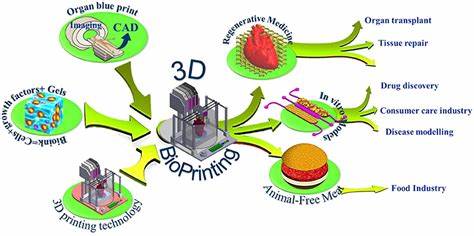Outline of the Article
- Introduction to 3D Printing
- Historical Overview of 3D Printing Technology
- Current State of 3D Printing Technology
- Applications of 3D Printing in Various Industries
- Healthcare
- Automotive
- Aerospace
- Architecture
- Fashion
- Education
- Advances in 3D Printing Technology
- Material Development
- Speed and Efficiency Improvements
- Multifunctional Printing
- Sustainability Efforts
- Future Prospects and Trends in 3D Printing
- Challenges and Limitations of 3D Printing
- Conclusion
Introduction to 3D Printing
In recent years, 3D printing technology has emerged as a revolutionary innovation with the potential to transform various industries. Unlike traditional manufacturing methods, which involve subtractive processes like cutting and drilling, 3D printing, also known as additive manufacturing, builds objects layer by layer from digital designs. This article explores the diverse applications and recent advances in 3D printing technology.
Historical Overview of 3D Printing Technology
Chuck Hull invented stereolithography in the 1980s, which gave rise to the idea of 3D printing. Since then, the technology has evolved rapidly, driven by advancements in materials, software, and printing techniques. Early applications were limited to prototyping and small-scale production. However, recent developments have expanded the scope of 3D printing to include complex geometries and diverse materials.
Current State of 3D Printing Technology
Today, 3D printing technology encompasses a wide range of processes, including fused deposition modeling (FDM), selective laser sintering (SLS), and stereolithography (SLA). These methods differ in their approach to layering materials and have unique advantages depending on the desired application. Additionally, improvements in printer hardware and software have led to greater precision, speed, and affordability.
Applications of 3D Printing in Various Industries
Healthcare
3D printing has revolutionized the healthcare industry by enabling personalized medical devices, prosthetics, and implants. Surgeons can now create custom implants tailored to individual patients, resulting in better outcomes and reduced recovery times.
Automotive
In the automotive sector, 3D printing is used for rapid prototyping, tooling, and manufacturing spare parts. Companies like BMW and Ford are exploring the potential of 3D printing to produce lightweight components and streamline production processes.
Aerospace
Aerospace manufacturers utilize 3D printing to produce complex aircraft components with reduced weight and improved performance. This technology enables the creation of intricate designs that would be challenging or impossible to manufacture using traditional methods.
Architecture
Architects and designers leverage 3D printing to create intricate models, prototypes, and even full-scale structures. This technology allows for greater design freedom and customization, leading to innovative architectural solutions.
Fashion
In the fashion industry, 3D printing enables designers to experiment with novel materials and avant-garde designs. Customized clothing, accessories, and footwear can be produced on-demand, reducing waste and inventory costs.
Education
3D printing has become an invaluable tool for education, allowing students to bring their ideas to life and gain hands-on experience with design and manufacturing processes. Educational institutions worldwide are incorporating 3D printing into their curriculum to prepare students for careers in STEM fields.
Advances in 3D Printing Technology
Material Development
Researchers are continually developing new materials for 3D printing, including biocompatible polymers, metals, ceramics, and composites. These materials offer enhanced properties such as strength, flexibility, and conductivity, expanding the possibilities for 3D-printed applications.
Speed and Efficiency Improvements
Advancements in printer technology have led to faster printing speeds and greater efficiency, reducing production times and costs. Continuous printing techniques, such as continuous liquid interface production (CLIP), enable rapid fabrication of complex geometries with minimal post-processing.
Multifunctional Printing
Multifunctional 3D printers capable of printing multiple materials simultaneously are enabling the creation of complex, functional assemblies in a single print. This technology opens up new possibilities for integrated electronics, embedded sensors, and other smart features.
Sustainability Efforts
3D printing offers environmental benefits such as reduced material waste, energy consumption, and transportation emissions compared to traditional manufacturing methods. Recycled and bio-based materials further enhance the sustainability of 3D-printed products, aligning with the growing demand for eco-friendly solutions.
Future Prospects and Trends in 3D Printing
The future of 3D printing holds exciting possibilities, including advancements in speed, scalability, and automation. As technology continues to evolve, we can expect to see increased adoption of 3D printing across industries, further blurring the lines between prototyping and mass production.
Challenges and Limitations of 3D Printing
Despite its many benefits, 3D printing still faces challenges such as limited material options, printing speed, and scalability for large-scale production. Quality control and regulatory compliance are also areas of concern, particularly in highly regulated industries like healthcare and aerospace.
Conclusion
In conclusion, 3D printing technology has transformed the way we design, produce, and consume goods across various sectors. From healthcare and automotive to architecture and fashion, the applications of 3D printing are diverse and far-reaching. With ongoing advances in materials, processes, and software, the future of 3D printing holds limitless potential for innovation and disruption.
FAQs
- Is 3D printing only used for prototyping?
- No, 3D printing is used for a wide range of applications, including manufacturing end-use parts, customized products, and architectural models.
- What materials can be used in 3D printing?
- Materials commonly used in 3D printing include plastics, metals, ceramics, and composites. Researchers are also exploring biodegradable and bio-based materials for sustainable manufacturing.
- How affordable is 3D printing technology?
- The cost of 3D printing technology has decreased significantly in recent years, making it more accessible to businesses and consumers alike. Entry-level desktop printers are available for a few hundred dollars, while industrial-grade printers can cost tens of thousands of dollars.
- What are the limitations of 3D printing?
- Some limitations of 3D printing include limited material options, printing speed, surface finish, and scalability for mass production. Additionally, certain geometries and designs may be challenging or impossible to print with current technology.
- How does 3D printing contribute to sustainability?
- 3D printing offers environmental benefits such as reduced material waste, energy consumption, and transportation emissions compared to traditional manufacturing methods. By using recycled and bio-based materials, 3D printing can further minimize its environmental footprint.
